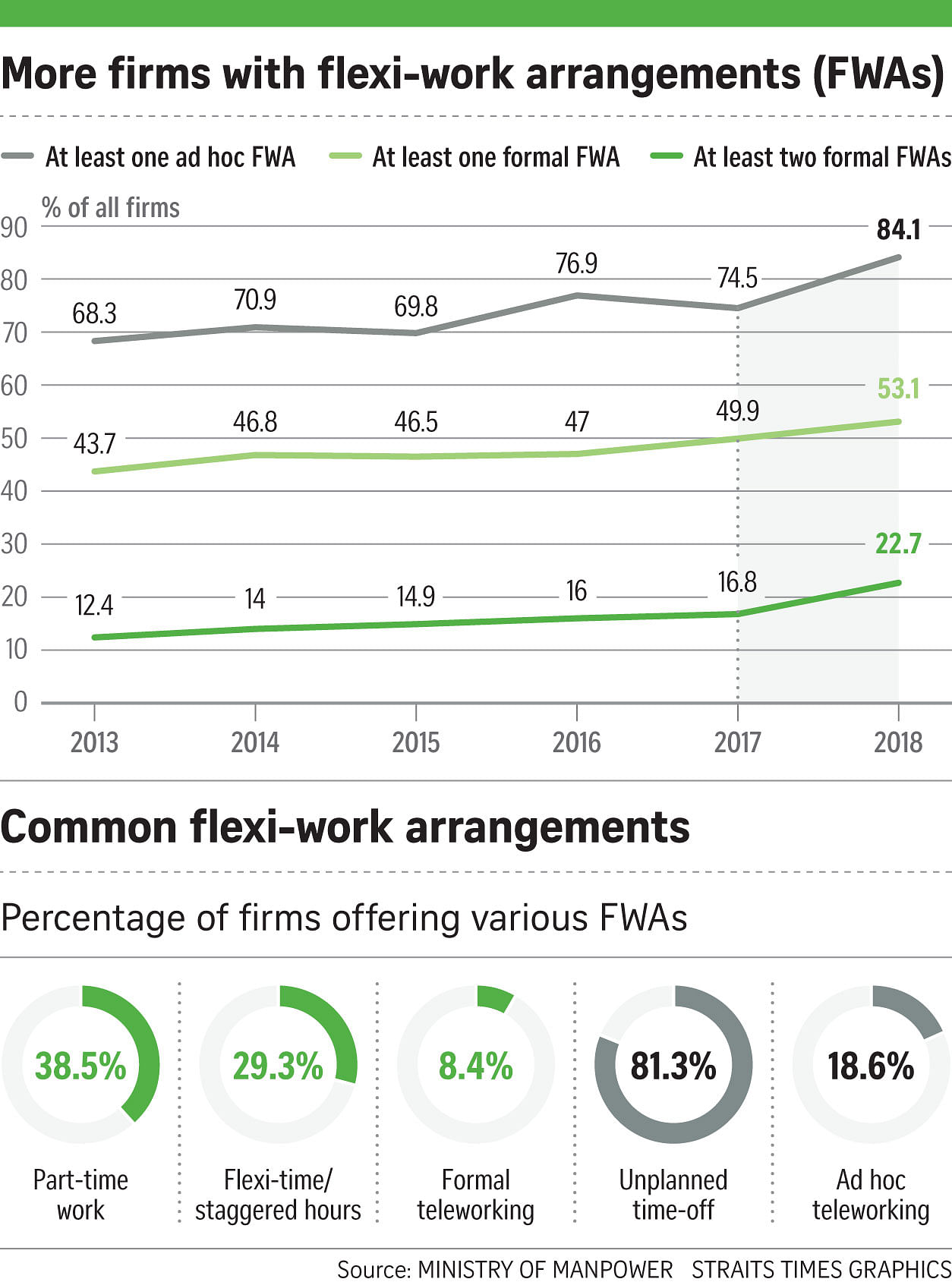Higher share of workers in firms offering flexi-work
Having flexible arrangements had most impact on staff retention, says MOM report
Sign up now: Get ST's newsletters delivered to your inbox

About 48 per cent of full-time employees were given at least 15 days of paid annual leave last year.
ST FILE PHOTO
Follow topic:
The share of workers here whose companies provide formal flexible work arrangements continues to grow, and employers are offering more types of such perks.
Last year, 72 per cent of employees worked in firms with at least one such arrangement, such as part-time work, flexible hours or teleworking, up from 70 per cent in 2017.
Also, more were offered at least one ad hoc, or impromptu, arrangement: The figure rose to 87 per cent last year, from 81 per cent in 2017, according to the latest Conditions of Employment report released by the Ministry of Manpower yesterday.
Just over half, or 53 per cent, of firms offered at least one type of formal flexi-work arrangement, up from 50 per cent in 2017.
Offering these arrangements makes business sense as employees are more likely to stay with a company with such options, especially as the new generation of workers values flexibility a lot more, said Minister of State for Manpower Zaqy Mohamad, who was sharing the findings at a human resources (HR) industry event.
"Employees, likewise, when offered flexible work arrangements, see it as a sign that they are valued by the company and that the company is willing to accommodate employees' responsibilities outside of work," he added.
Employees also feel that the company trusts them to get the work done even though they are not sitting at their desks, he said.
The provision of flexible arrangements had the greatest impact on staff retention among various workplace practices, the report said.
The biennial report, which covered some 1.3 million workers and 3,700 firms, said increases in annual leave entitlement and reductions in the number of work days per week led to the next biggest decreases in resignation rates.
Compared with the previous report in 2016, more full-time employees - about 48 per cent - were given at least 15 days of paid annual leave last year, up from about 45 per cent.

-
72%
Percentage of employees who worked in firms that offered at least one formal flexible work arrangement - up from 70 per cent in 2017.
87%
Percentage of employees who were offered at least one ad hoc, or impromptu, arrangement - up from 81 per cent in 2017.
53%
The share of firms offering at least one type of formal flexi-work arrangement, a slight increase from 50 per cent in 2017.
The prevalence of flexi-work arrangements in Singapore is still lower than in countries like Japan and South Korea, noted Institute for Human Resource Professionals chief executive Mayank Parekh. One reason could be that many smaller firms choose not to formalise their flexible arrangements in order to retain management control and flexibility.
Association of Small and Medium Enterprises (ASME) vice-president Chew Lee Ching said small and medium-sized businesses recognise in principle that flexi-work arrangements can be a way to retain staff amid the labour crunch, but most do not have spare manpower capacity to offer them.
It may also be harder for firms to implement such arrangements in jobs where teams are needed for operations, such as on the factory floor or in front-line service, said Singapore Human Resources Institute (SHRI) president Erman Tan. "But with good technology and smart deployment, they can start to reduce their reliance on manpower."
Highlighting successful case studies in various industries could help change employers' mindsets, he added.
Besides educating employers, it may be necessary to educate workers on flexible schemes as well.
Ms Charlotte Thng, Standard Chartered Bank's head of HR for Singapore, said staff were worried about how supervisors would perceive their productivity when the bank first introduced flexi-work arrangements in 2011.
"When they saw their performance ratings were still good, they got over their concerns," she said, adding that the bank sent out e-mail broadcasts, walked supervisors through the schemes, and now holds roadshows to explain the schemes to employees.
The take-up rate has tripled in the last three years, and staff on flexible arrangements now number in the hundreds out of the bank's 9,000-strong workforce here, she said.
This has contributed to a 4 per cent drop in the voluntary attrition rate over the last three years. "Employees get a sense of trust, space and flexibility, while supervisors get the work as agreed on in the performance objectives," Ms Thng added.
Mr Zaqy, who was speaking at the SHRI Outlook event at One Marina Boulevard, also took part in a dialogue with some 200 HR professionals and business leaders. They discussed topics including remaining open to foreign talent, retaining younger workers and managing the rising cost of medical benefits as workers age.
Also at the event, SHRI and ASME signed an agreement to set up a centre to provide practical support to bosses of smaller firms who want to improve their HR practices. They aim to open the SHRI SME Human Capital Centre next year.

